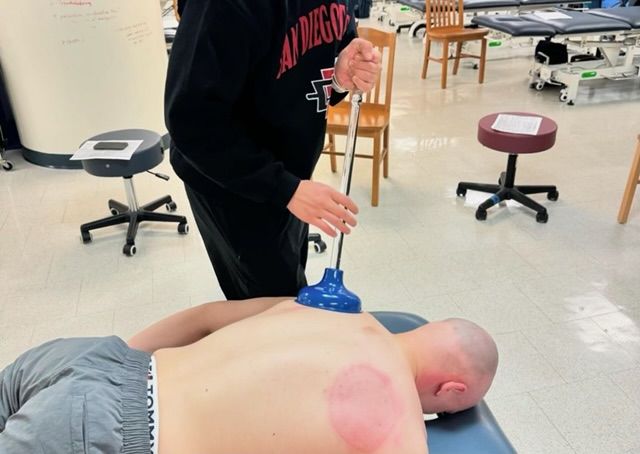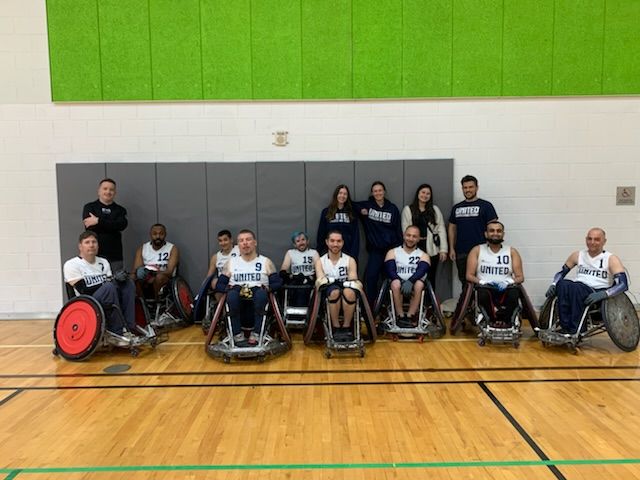Not all learning takes place in a classroom. Just ask physical therapy students involved with two new special interest groups at the George Washington University (GW) School of Medicine and Health Sciences (SMHS).
The two student-run groups, Neuro Club and Manual Therapy Club, meet about once a month outside of class to discuss topics of interest. Faculty members serve as advisors.
The Neuro group, as its name suggests, focuses on neurological physical therapy and offers interested students additional labs and talks from special guests. Club members explore topics related to conditions affecting the brain, spinal cord and nervous system, such as stroke, spinal cord injury and Multiple sclerosis. Karen Goodman, PT, DPT, assistant professor in SMHS’s Department of Health, Human Function and Rehabilitation Sciences and academic director of MedStar NRH/GW Neurologic Residency Program, serves as advisor of the group.
One of the club’s leaders, Gray Weaver (DPT ’25), said bringing patients and community members to campus helps students gain new perspectives on what it is like to live with and manage neurological conditions. “It takes us a step beyond studying the scientific nature of a disorder to hear the lived experience – hearing about the little nuances that affect their daily life… that enhances our learning so much,” Weaver said. Amanda Seethaler (DPT ’25) also leads the group that got its start in 2023.
Seethaler and Weaver plan to host more guest speakers in the future and hope to motivate their classmates to consider a future in neurological PT. “We can be the voice of advocacy for change in environmental setup to make it easier for people who may not have a voice… and we can be the providers who help our patients maintain functional levels in a society that is not made for them,” Weaver said. “There is a lot that we still don’t understand, and with that, lots of room for advancement in this field. This is something that we as student physical therapists can improve upon in the future.”
The second group, the Manual Therapy Club, was organized to give PT students additional opportunities to learn and practice hands-on techniques to treat musculoskeletal pain and other disabilities. Orthopedic residents and, experienced clinicians work with first and second-year PT students work on treatment options. Dhinu Jayaseelan (DPT ’10), associate professor and co-academic director of the orthopaedic residency at SMHS, is the club advisor.
Club meetings have covered various techniques within manual therapy. Christopher Regalado (DPT’25), one of the group’s leaders, recalls learning the McKenzie Method – an assessment and management approach for back, neck and extremity injuries – as one of his favorite experiences. “It’s cool to learn from people that we haven’t learned from before in class,” Regalado said. “It was fascinating to hear the thought process… I don’t know if I will utilize the McKenzie Method as a practicing clinician, but this experience has certainly piqued my interest.”
Ella Roberts (DPT ‘25), and Jesse Ntawutarama (DPT ’25), who lead the club with Regalado, want to invite more GW PT alumni to teach new techniques to students. “Having an outside look from alumni would be helpful,” Roberts said.
When asked why manual therapy is an important PT subspecialty, Roberts cited how it is one piece of the “wellness pie” in treating patients. She noted that the hands-on nature of manual skills also builds comfort and trust with patients, preparing students for a more beneficial therapy session.
Aside from giving students opportunities to learn more about specialized areas within PT, both clubs also allow students to exercise leadership skills. The clubs hope to motivate students to seek out new and evidence-based knowledge which will contribute to their success as health care providers.

